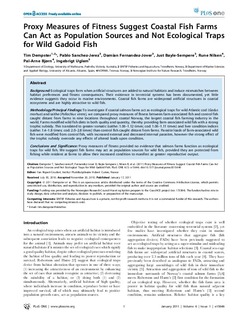| dc.contributor.author | Dempster, Timothy David | |
| dc.contributor.author | Sánchez-Jerez, Pablo | |
| dc.contributor.author | Fernandez-Jover, Damian | |
| dc.contributor.author | Bayle-Sempere, Just | |
| dc.contributor.author | Nilsen, Rune | |
| dc.contributor.author | Bjørn, Pål Arne | |
| dc.contributor.author | Uglem, Ingebrigt | |
| dc.date.accessioned | 2018-08-01T06:53:11Z | |
| dc.date.available | 2018-08-01T06:53:11Z | |
| dc.date.created | 2011-11-28T11:01:48Z | |
| dc.date.issued | 2011 | |
| dc.identifier.issn | 1932-6203 | |
| dc.identifier.uri | http://hdl.handle.net/11250/2507053 | |
| dc.description.abstract | Background: Ecological traps form when artificial structures are added to natural habitats and induce mismatches between habitat preferences and fitness consequences. Their existence in terrestrial systems has been documented, yet little evidence suggests they occur in marine environments. Coastal fish farms are widespread artificial structures in coastal ecosystems and are highly attractive to wild fish. Methodology/Principal Findings: To investigate if coastal salmon farms act as ecological traps for wild Atlantic cod (Gadus morhua) and saithe (Pollachius virens), we compared proxy measures of fitness between farm-associated fish and control fish caught distant from farms in nine locations throughout coastal Norway, the largest coastal fish farming industry in the world. Farms modified wild fish diets in both quality and quantity, thereby providing farm-associated wild fish with a strong trophic subsidy. This translated to greater somatic (saithe: 1.06-1.12 times; cod: 1.06-1.11 times) and liver condition indices (saithe: 1.4-1.8 times; cod: 2.0-2.8 times) than control fish caught distant from farms. Parasite loads of farm-associated wild fish were modified from control fish, with increased external and decreased internal parasites, however the strong effect of the trophic subsidy overrode any effects of altered loads upon condition. Conclusions and Significance: Proxy measures of fitness provided no evidence that salmon farms function as ecological traps for wild fish. We suggest fish farms may act as population sources for wild fish, provided they are protected from fishing while resident at farms to allow their increased condition to manifest as greater reproductive output. | |
| dc.description.abstract | Proxy Measures of Fitness Suggest Coastal Fish Farms Can Act as Population Sources and Not Ecological Traps for Wild Gadoid Fish | |
| dc.language.iso | eng | |
| dc.title | Proxy Measures of Fitness Suggest Coastal Fish Farms Can Act as Population Sources and Not Ecological Traps for Wild Gadoid Fish | |
| dc.title.alternative | Proxy Measures of Fitness Suggest Coastal Fish Farms Can Act as Population Sources and Not Ecological Traps for Wild Gadoid Fish | |
| dc.type | Peer reviewed | |
| dc.type | Journal article | |
| dc.description.version | publishedVersion | |
| dc.source.volume | 6 | |
| dc.source.journal | PLoS ONE | |
| dc.source.issue | 1 | |
| dc.identifier.doi | 10.1371/journal.pone.0015646 | |
| dc.identifier.cristin | 861972 | |
| cristin.unitcode | 7543,0,0,0 | |
| cristin.unitname | NOFIMA | |
| cristin.ispublished | true | |
| cristin.fulltext | original | |
| cristin.qualitycode | 1 | |
